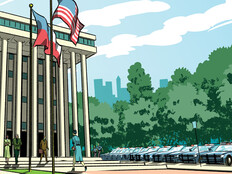Candid Cops
Maybe the driver of the white pickup didn’t see the stop sign. He certainly didn’t see the police cruiser a few blocks away. The patrolman saw it all, however.Thanks to digital video and storage, so could a judge, if necessary.
The Horsham Township (Pa.) Police Department patrolman who stopped the driver — and let him off with just a warning — captured the incident with a video camera mounted on the cruiser’s dashboard and a wireless microphone clipped to the officer’s shirt.
While the foot-age is hardly the stuff of reality TV, the technology is a blockbuster among law enforcement. Police departments in all 50 states and the District of Columbia have turned to videotape technology to combat crime and guard against lawsuits. A 2007 U.S. Supreme Court majority opinion praising in-car police footage has helped drive deployment.
The result of all this videotaping: Court convictions have increased and citizens’ complaints about police behavior have dropped in areas where the technology has been deployed, according to research from the International Association of Chiefs of Police. “We give police officers bullet-proof vests to protect their lives,” says Dennis Blackburn, a dispatcher and records clerk in Horsham who also serves as the department’s network administrator. “Videotape protects their reputations.”
Roll the Tape
According to a study from the International Association of Chiefs of Police, 26 percent of officers became more accepting of videotape technology after their agencies implemented in-car cameras.
Early this year, Blackburn outfitted the township’s 11 police cruisers with the Panasonic Toughbook-Arbitrator, a mobile digital-video system that includes a camera, wireless microphone and videotape unit. He also deployed software to store, label and wirelessly transmit video for later retrieval. “I can pull up anything within a matter of moments,” says Blackburn. “I can search by time, user or a bookmark that the officer puts on stored footage. For example, I can see that we have [video of] all the DUIs since April.”
The video is high-resolution, recorded and transferred at 1 megabyte per second. “We had thought about using 512 [kilobytes per second]. The vendor said that would be fine, unless it’s raining out, in which case lower-resolution images tend to blur,” says Blackburn. “I talked with the chief and we both agree that rainy nights are when we get most of our calls.”
Storing all that video, even when recorded in snippets, requires a lot of space. One summer night, for example, the Horsham police recorded 81 separate incidents requiring 4.5 gigabytes of storage. That’s why Blackburn installed two 1.4-terabyte network-attached storage devices, one used for short-term files, the other for archiving.
The storage, though, begins right in the patrol car’s video system, which can store up to 32 hours of high- resolution, 30-frame-per-second video. The Panasonic camera is always recording whenever the car is in use, maintaining 30 seconds of video in cache memory at all times. When the patrolman turns on the unit — or it is triggered by the car’s siren or lights — video is moved from the camera’s cache memory to the 16GB flash card contained in the Toughbook-Arbitrator. Once the car returns to police headquarters, officers use their Toughbook notebooks to transmit that day’s video over a 802.11g wireless connection to the NAS units inside.
A Prudent Investment
In-car video units typically cost about $5,000 to $7,000, not including the cost of storage and file management software. Horsham spent about $70,000 for the video gear.
But while police departments cannot always calculate a return on investment, most agree that digital in-car video systems reduce costs associated with record-keeping and litigation.
Record-keeping costs are slashed because police department employees no longer have to sift through hours of analog tape to produce evidence for prosecutors and defense attorneys. Say, for example, an agency with a fleet of 100 patrol cars retrieves data from each car’s tapes every five days — or 7,300 times a year. Given that it takes a supervisor 15 minutes to collect and log each tape, and another 45 minutes to 2 hours each month to respond to an average of 30 requests for evidence from prosecutors and defense attorneys — reasonable estimates, according to the International Association of Chiefs of Police — the supervisor can anticipate spending minimally 2,095 hours each year handling analog tapes. If the supervisor is paid $30 an hour, the police department will spend more than $62,850 a year on administrative costs for analog-tape retrieval.
Departments may reap the largest savings by avoiding litigation, though how many potential litigants reconsidered after learning they had been videotaped is unknown.
“Seems that most people, understanding they have been recorded, don’t put up a big fuss in court,” says Blackburn. “I guess just the fact that we could play the video with the infraction keeps them from fighting it too hard.”
Self-Defense
As video technology rapidly improves, cameras are becoming standard issue in many police forces. Their adherents explain the many benefits.
- “First and foremost, they protect the troopers from unwarranted and unfounded accusations from disgruntled offenders. They most certainly have aided in prosecutorial efforts. Attorneys are less eager to pursue cases where the video depicts circumstances contrary to their clients’ assertions. Videos are used by administrative personnel to critique our training methods and needs. The Office of Professional Responsibility reviews videos to corroborate troopers’ statements and actions when complaints are received. The videos are also examined by supervisors to denote patterns or trends or exceptional performance by subordinates.” —Lt. Darrell Miller, Tennessee Highway Patrol
- “Officers realize the benefits of having a camera: It protects them from false allegations of misconduct, and it also assists them in prosecuting cases. Technological advances allow for the enhancement of video for evidentiary purposes [and have] also led to much better video quality.” —Sgt. Wayne Kline, Pennsylvania State Police Bureau of Patrol
- “It’s turned into more of an officer-safety device than a tool for prosecution.” —Lt. Jim Halvorsen, New York State Police







